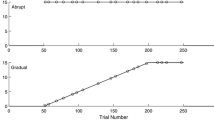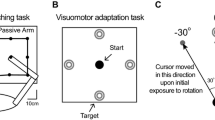Abstract
This study investigated differences in adaptation to a novel dynamic environment between the dominant and nondominant arms in 16 naive, right-handed, neurologically intact subjects. Subjects held onto the handle of a robotic manipulandum and executed reaching movements within a horizontal plane following a pseudo-random sequence of targets. Curl field perturbations were imposed by the robot motors, and we compared the rate and quality of adaptation between dominant and nondominant arms. During the early phase of the adaptation time course, the rate of motor adaptation between both arms was similar, but the mean peak and figural error of the nondominant arm were significantly smaller than those of the dominant arm. Also, the nondominant limb’s aftereffects were significantly smaller than in the dominant arm. Thus, the controller of the nondominant limb appears to have relied on impedance control to a greater degree than the dominant limb when adapting to a novel dynamic environment. The results of this study imply that there are differences in dynamic adaptation between an individual’s two arms.







Similar content being viewed by others
References
Bagesteiro LB, Sainburg RL (2002) Handedness: Dominant arm advantages in control of limb dynamics. J Neurophysiol 88:2408–2421
Brashers-Krug T, Shadmehr R, Bizzi E (1996) Consolidation in human motor memory. Nature 382:252–255
Caithness G, Osu R, Chase H, Klassen J, Kawato M, Wolpert DM, Flanagan JR (2004) Failure to consolidate the consolidation theory of learning for sensorimotor adaptation tasks. J Neurosci 24(40):8662–8671
Conditt MA, Gandolfo F, Mussa-Ivaldi FA (1997) The motor system does not learn the dynamics of the arm by rote memorization of past experience. J Neurophysiol 74:2174–2178
Criscimagna-Hemminger SE, Donchin O, Gazzaniga MS, Shadmehr R (2003) Learned dynamics of reaching movements generalize from dominant to nondominant arm. J Neurophysiol 89:168–176
Duff SV, Sainburg RL (2006) Lateralization of motor adaptation reveals independence in control of trajectory and steady-state position. Exp Brain Res Dec 15 (Epub ahead of print)
Flanagan JR, Wing AM (1997) The role of internal models in motor planning and control: evidence from grip force adjustments during movements of hand-held loads. J Neurosci 17:1519–1528
Flash T, Mussa-Ivaldi F (1990) Human arm stiffness characteristics during the maintenance of posture. Exp Brain Res 82(2):315–326
Franklin DW, Milner TE (2003) Adaptive control of stiffness to stabilize hand position with large loads. Exp Brain Res 152:211–220
Franklin DW, Osu R, Burdet E, Kawato M, Milner TE (2003) Adaptation to stable and unstable dynamics achieved by combined impedance control and inverse dynamics model. J Neurophysiol 90:3270–3282
Gomi J, Osu R (1998) Task-dependent viscoelasticity of human multijoint arm and its spatial characteristics for interaction with environments. J Neurosci 18:8965–8978
Gomi J, Osu R (1999) Multijoint muscle regulation mechanisms examined by measured human arm stiffness and EMG signals. J Neurophysiol 81:1458–1468
Hidler J, Nichols D, Pelliccio M, Brady K (2005) Advances in the understanding and treatment of stroke impairment using robotic devices. Top Stroke Rehabil 12(2):22–35
Lum PS, Reinkensmeyer DJ, Mahoney R, Rymer WZ, Burgar CG (2002) Clinical considerations in the use of robotic devices for movement therapy following stroke. Top Stroke Rehabil 8(4):40–53
Malfait N, Ostry DJ (2004) Is interlimb transfer of force-field adaptation a cognitive response to the sudden introduction of load? J Neurosci 24:8084–8089
Milner TE, Franklin DW (2005) Impedance control and internal model use during the initial stage of adaptation to novel dynamics in humans. J Physiol 567:651–664
Milner TE, Hinder MR (2006) Position information but not force information is used in adapting to changes in environmental dynamics. J Neurophysiol 96:526–534
Mussa-Ivaldi FA, Hogan N, Bizzi E (1985) Neural, mechanical, and geometric factors subserving arm posture in humans. J Neurosci 5:2732–2743
Nozaki D, Kurtzer I, Scott SH (2006) Limited transfer of learning between unimanual, bimanual skills within the same limb. Nat Neurosci 9(11):1364–1366
Oldfield RC (1971) The assessment and analysis of handedness: the Edinburgh Inventory. Neuropsychologia 1:97–113
Osu R, Burdet E, Franklin DW, Milner TE, Kawato M (2003) Different mechanisms involved in adaptation to stable and unstable dynamics. J Neurophysiol 90:3255–3269
Parlow SE, Kingsbourne M (1989) Asymmetrical transfer of training between hands: Implications for interhemispheric communication in normal brain. Brain Cogn 11:98–113
Patton JL, Stoykov ME, Kovic M, Mussa-Ivaldi FA (2006) Evaluation of robotic training forces that either enhance or reduce error in chronic hemiparetic stroke survivors. Exp Brain Res 168:368–383
Sainburg RL (2002) Evidence for a dynamic-dominance hypothesis of handedness. Exp Brain Res 142:241–258
Sainburg RL, Duff SV (2006) Does motor lateralization have implications for stroke rehabilitation? JRRD 43:311–322
Sainburg RL, Kalakanis D (2000) Differences in control of limb dynamics during dominant and nondominant arm reaching. J Neurophysiol 83:2661–2675
Sainburg RL, Wang J (2002) Interlimb transfer of visuomotor rotations: independence of direction and final position information. Exp Brain Res 145:437–447
Scheidt RA, Stoeckmann T (2007) Reach Adaptation and Final Position Control Amid Environmental Uncertainty Following Stroke. J Neurophysiol Jan 31 (Epub ahead of print)
Scheidt RA, Reinkensmeyer DJ, Conditt MA, Rymer WZ, Mussa-Ivaldi FA (2000) Persistence of motor adaptation during constrained, multi-joint arm movements. J Neurophysiol 84:853–862
Scheidt RA, Dingwell J, Mussa-Ivaldi FA (2001) Learning to move amid uncertainty. J Neurophysiol 86:971–985
Shadmehr R, Brashers-Krug T (1997) Functional stages in the formation of human long-term motor memory. J Neurosci 17:409–419
Shadmehr R, Mussa-Ivaldi FA (1994) Adaptive representation of dynamics during learning of a motor task. J Neurosci 14:3208–3224
Takahashi C, Reinkensmeyer D (2003) Hemiparetic stroke impairs anticipatory control of arm movement. Exp Brain Res 149:131–140
Takahashi C, Scheidt R, Reinkensmeyer D (2001) Impedance control and internal model formation when reaching in a randomly varying dynamical environment. J Neurophysiol 86:1047–1051
Taylor HG, Heilman KM (1980) Left-hemisphere motor dominance in righthanders. Cortex 16:587–603
Thoroughman KA, Shadmehr R (2000) Learning of action through adaptive combination of motor primitives. Nature 407:742–746
Volpe BT, Ferraro M, Krebs HI, Hogan N (2002) Robotics in rehabilitation treatment of patients with stroke. Curr Atheroscler Rep 4(4):270–276
Wang J, Sainburg RL (2004a) Limitations in interlimb transfer of visuomotor rotations. Exp Brain Res 155:1–8
Wang J, Sainburg RL (2004b) Interlimb transfer of novel inertial dynamics is asymmetrical. J Neurophysiol 92:349–360
Acknowledgments
The authors would like to show our appreciation to Lindsay DiRomualdo, Daniela Monterrubio and Shannon O’Brien for assisting with subject recruitment, testing and analysis. We also acknowledge the Imaging Science and Information Systems (ISIS) Center at Georgetown University for providing the InMotion2 robot.
Author information
Authors and Affiliations
Corresponding author
Rights and permissions
About this article
Cite this article
Schabowsky, C.N., Hidler, J.M. & Lum, P.S. Greater reliance on impedance control in the nondominant arm compared with the dominant arm when adapting to a novel dynamic environment. Exp Brain Res 182, 567–577 (2007). https://doi.org/10.1007/s00221-007-1017-x
Received:
Accepted:
Published:
Issue Date:
DOI: https://doi.org/10.1007/s00221-007-1017-x




